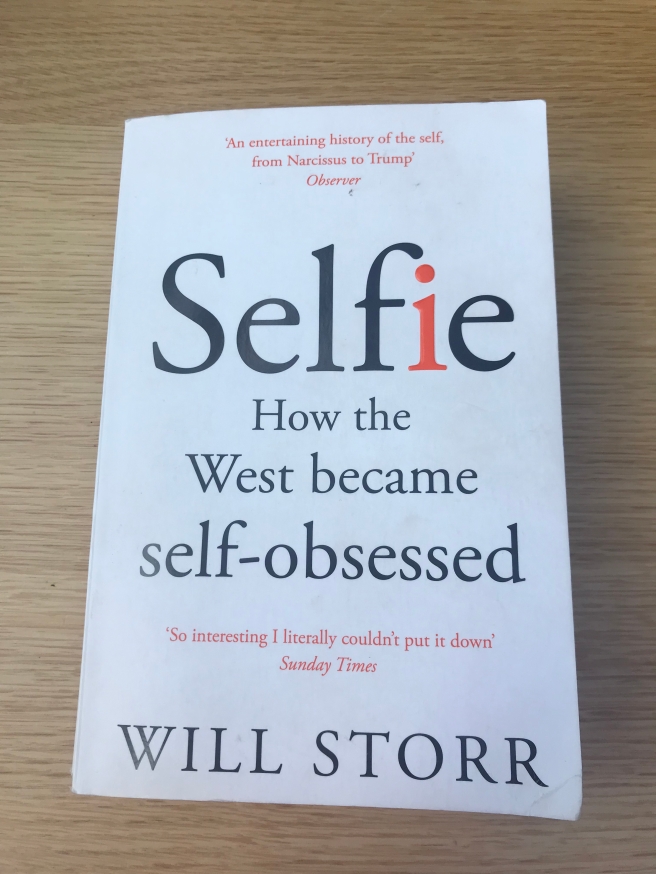I purchased this book by Will Storr as it looked like it might add to my research on Selfies.

What a fascinating read, I started dog-earing pages of interest until I realised that I was dog-earing the majority of the book! In short the book chronicles the human self from ancient history to the present day and its connections in time with psychology, economics and culture.
Interestingly it seems that according to this book our Westernised Self can be traced back to the early Greeks and Romans. The closest thing that the Greeks had to heaven was Elysium, invitations to Elysium were based on status and not self worth. They saw themselves as individuals rather than part of a connected whole much as we do today. We are tribal and we have a sense of working towards our own personal goals, there is hierarchy and as Aristotle believed it is natural to be competitive and it is natural to move towards perfection.
In the East however they are moulded from the era of Confucius, the belief being that the superior man has nothing to compete for, he is not boastful but conceals his virtue. The superior man allows for equilibrium and group harmony to exist in perfection. Confucius expected people to do the right thing simply because it was the right thing to do, not for award or praise.
Interestingly the book points out how much of these ancient beginnings are still evident today, and how differently the East and West think about the world around them. The book mentions showing Westerners and Easterners pictures for 3 seconds, the Westerners would look at the main object and only occasionally drift out to the context. The Chinese looked constantly back and forth between object and context. In another study they looked as news reports of mass murderers, the Western press would blame flaws in the killers character whereas the Chinese press focused on contributing external factors.
There is also no word for individualism in the Chinese language, the closet to it would translate to selfishness.
Our Western selves have hero’s and villains, we have happy endings to our stories but in easterner stories known as kishotenketsu you are meant to find harmony in the story and the ending is left open for you to ponder, you have to find the answers for yourself.
I found this difference , an East /West divide interesting. Suicide was another statistic explored and again there is a difference in that suicide in the western world is more about the individual whereas suicide in the Eastern world is to protect others or the group, to bring harmony.
I am not what I think I am and I am not what you think I am; I am what I think that you think I am – Charles Horton Cooley (Sociologist)
From the age of 2 we start interacting with others and forming groups, to participate you need a sense of self, you start developing prejudices and biases, you develop hierarchies in your groups.
if others believe we are fancy and great, our looking-glass self interprets that as evidence that we ARE fancy and great. We’re self-conscious. we use clues from out there to tell us who we are in here.
We crave good reputation and feeling good, we are motivated by positive feelings and avoid the negative. We work to earn a living, to satisfy our basic needs of food and shelter but after this we need validation and self-worth. We continually adapt and change depending on the people that surround us or the situations we are in so we are not truly ‘one’ person but a fluid individual.
The Western Self moved on through the ages, through the Christians struggle with the inner self, Freud and many others all leaving their mark on who we are today. The period of ‘Self-Esteem’ which meant that no one fails, there were no winners in school races and the dreaded red pen used by teachers was replaced with a more placid green.
The current stage we are in is the age of Perfectionism, we have gone full circle back to out ancient Greeks. We tend to judge people more including ourselves, we are strong yet sensitive at the core. suicide rates are rising as more people fail to achieve their sense or perfect. Money and status are important and consumer consumption may be at the heart of it.
We live in an age of information, it is everywhere; in the shops, on tv, in the papers telling us we can loss weight, have nicer smiles, drive fancy cars, help ourselves to succeed in life… does this all really stem from the Ancient Greeks? Is it really because they believed that being physically beautiful equated to being ethically good and being physically ugly was the same as being bad, the word for this is kalokagathia (Kalos means beautiful, Kai means ‘and’, and agathos means good)?
Well this book has curtained made me understand more about the evolution of our ‘Self’ as well as understanding the differences between the East and West self.


